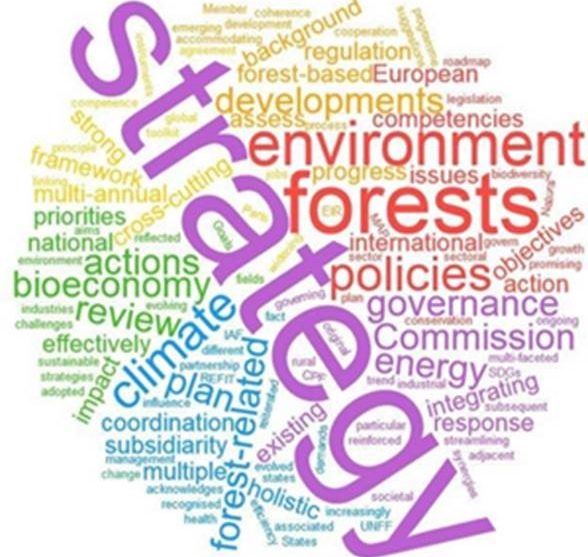
Forest & Biodiversity Strategies
On 16 July 2021, the European Commission published its Communication on the “New EU Forest Strategy for 2030 (COM(2021) 572)” together with an accompanying Staff Working Document “The 3 Billion Tree Planting Pledge For 2030 (SWD(2021) 651)”. In its Communication, the Commission acknowledges the increasing and sometimes competing demands on forests and sets, in this respect, priorities to ensure that the amount of wood we use remains within the sustainability limits and is optimally utilised in line with the cascading principle and the circular economy approach. In that manner it caters as much as possible for substituting fossil based by long-lived circular materials and products that are of highest value for carbon storage and circular economy.
Cascading principle
The cascading principle is set as crucial for building a sustainable and climate-neutral economy and to optimise the use of wood, in particular through market incentives. This means that wood should be used as much as possible for long-lived materials and products to substitute their carbon intensive and fossil-based counterparts, for example in buildings and furniture, whilst acknowledging that not all wood is fit for such purpose. The processing innovations in this field can also provide bio-based materials and products with lower environmental footprint than the fossil-based ones. Short-lived wood-based products also have a role to play, especially in substituting their fossil-based counterparts. Wood used for the production of short-lived products and also for energy production should rely on wood that is unsuitable for long-lived materials and products, and secondary woody biomass such as sawmill by-products, residues and recycled materials. Priority should be on better using, reusing and recycling all wood-based products, including for example from construction and demolition sites, as enhanced circularity of products offers a possibility of maintaining all wood-based products longer in the economy for the multiple uses.
Promoting sustainable forest bioeconomy for long-lived wood products
The Communication underlines that, within the boundaries of sustainable availability and supply of wood, the forest-based sector holds significant economic potential for improving its production of sustainable and legally harvested wood for circular and long-lived materials and products. This requires stimulating the demand in downstream industries and promoting forest management practices, production tools and processes that are better adapted to different future forest resources. To increase the supply of long-lived wood products, investments are needed throughout the wood processing chain. Wood processing industries should be supported to better adapt to the changing and diversifying resources of forests. Investments should also focus on the production of long-lived wood products from lower quality logs, from more hardwood species, and anticipating greater fluctuations in production over time.
Promoting wood in construction and renovation
From this perspective, the Commission stresses that the most important role of wood products is to help turn the construction sector from a source of greenhouse gas emissions into a carbon sink, as set out in the Renovation Wave Strategy and the new European Bauhaus initiative. There is considerable room for improvement. With less than 3% of market share, wood products are still only a tiny fraction of building materials in Europe that largely remain dominated by energy intensive and currently fossil fuel-based materials. The Commission will develop a 2050 roadmap for reducing whole life-cycle carbon emissions in buildings. In the context of the revision of the Construction Products Regulation, the Commission will develop a standard, robust and transparent methodology to quantify the climate benefits of wood construction products and other building materials.
Re- and afforestation of biodiverse forests: 3 billion tree planting by 2030
The roadmap sets out clear criteria for tree planting, counting and monitoring. It is supplemented by a website, a timeline for how additional elements will be developed, including a tree-counter, the ongoing development of the guidelines for biodiversity-friendly afforestation and reforestation and criteria for closer-to-nature forestry, and platforms for exchange of best practices. Assuming the 3 billion trees are distributed over about 2 million ha within the next decade, they could potentially remove from the atmosphere approximately 4 million tonnes CO2 in 2030 and 15 million tonnes CO2 in 2050.
- EP Text Adopted New Forest Strategy for 2030
- EP Report on EU Biodiversity Strategy for 2030 – Bringing nature back into our lives
- COM(2021)572 – new EU Forest Strategy for 2030
- COM(2021)572 – new EU Forest Strategy for 2030 – Roadmap 3 Billion Tree Planting
- COM(2021)572 – new EU Forest Strategy for 2030 – Annex
- EP Report on the EU Biodiversity Strategy for 2030 – Bringing nature back into our lives
- EPF Response – Public consultation on a new EU forest strategy
- EPF Position Paper on European Plywood Industry and Climate Change
- EPF Response – Public consultation on EU biodiversity policy initiatives
- Forest Strategy – The Way Forward 2019 2157(INI) – amendments EPF_EOS_FEP
- Joint Statement -The New EU Forest Strategy: 3 reasons to endorse the Committee report
- COM Biodiversity Strategy 2030
- 2020-97 EPF Feedback on EU Forest Strategy Roadmap
- EP Report on the European Forest Strategy – The Way Forward
- EPF Answers – EU Timber Regulation and FLEGT Regulation Fitness Check
- EPF response on Deforestation and Forest Products Impact AssessmentÂ
- Joint Press Release of the Woodworking Industries – Forest Strategy :The Way Forward

